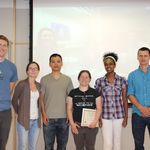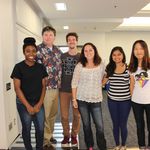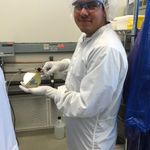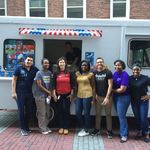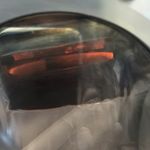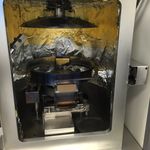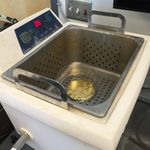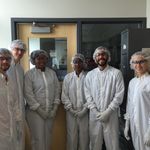2015 News and Updates
Closing Certificate Ceremony for NSF REU INM – August 12, 2015
As a sweet ending to our first year, the REU and RET participants were led to a final meeting where instead of learning more before the end of the program, they were met with an ice cream sundae social and a certificate ceremony. Each student was presented with a participation certificate and took final pictures with their labs. It was a great first summer and we look forward to recruiting for next year!
Enjoy this photo gallery as a final slideshow of our REU/RET summer:
Certificates and Lab Photos
A final gallery of lab photos from the summer
Final Poster Presentation – Wrapping Up the Summer, August 7, 2015.
This morning the participants of REU and RET presented the projects they have been working on in lab all summer. Set up on high-tech, LED monitors, each poster was detailed and organized, presenting graphs, videos and other visuals to allow the audience a clear understanding of what went on in Photonics these past ten weeks. Many REU/RET pairs presented their work together, like Jake Highleyman and Ryan Grams, helping each other explain their processes and research. Others, like Stephanie Emenyonu and Eric Jackson, presented separate posters to better explain their different fi
and other visuals to allow the audience a clear understanding of what went on in Photonics these past ten weeks. Many REU/RET pairs presented their work together, like Jake Highleyman and Ryan Grams, helping each other explain their processes and research. Others, like Stephanie Emenyonu and Eric Jackson, presented separate posters to better explain their different fi ndings. Although their goal was the same, each attempted to reach that goal with a different method. One turned out to be better than the other as the results were more clear, and as they presented their different methods, they also explained how they worked off of each other and what that may lead to with future research. Overall, the turnout at the poster session was great and each participant was given a moment to explain and be recognized for their hard work this summer. After the presentation, the REU participants presented Helen Fawcett, the co-PI of the REU program, with a thoughtful gift to say “thank you” for all of her hard work. This summer could not have been possible without her and Prof. Xin Zhang.
ndings. Although their goal was the same, each attempted to reach that goal with a different method. One turned out to be better than the other as the results were more clear, and as they presented their different methods, they also explained how they worked off of each other and what that may lead to with future research. Overall, the turnout at the poster session was great and each participant was given a moment to explain and be recognized for their hard work this summer. After the presentation, the REU participants presented Helen Fawcett, the co-PI of the REU program, with a thoughtful gift to say “thank you” for all of her hard work. This summer could not have been possible without her and Prof. Xin Zhang.
Brown Bag Seminar – Introduction to Societal Engineer® ARROWS and STEM outreach, August 5, 2015, Gretchen Fougere, Prof. Joyce Wong and Prof. Kathryn Spilios
Today, our REU and RET participants learned first hand of the STEM initiatives at Boston University. We were fortunate to have Gretchen Fougere, Associate Dean for Outreach & Diversity at the College of Engineering discuss introduce the College of Engineering’s Societal Engineer® and the programs that she oversees with undergraduates in the College of Engineering who integrate curriculum supplemental material to classrooms locally from from their hometowns (Inspiration Ambassadors). The goal is to help students in high school and middle school understand what engineers do and help supplement what is being taught in the curriculum. In addition, she spoke of the STEEP program where 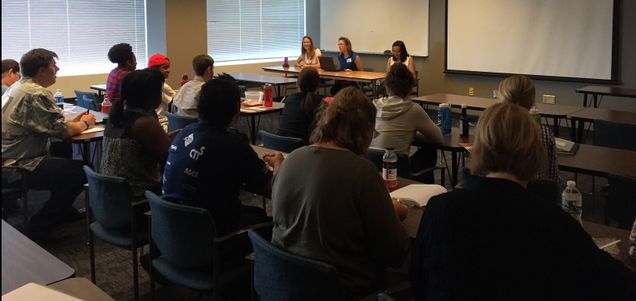 engineering students exit after five years with an undergraduate degree in engineering and a master’s degree in teaching. Prof. Joyce Wong, who is a Professor of Biomedical and Materials Science and Engineering as well as Director of a new effort aimed at advancing women in these critical fields at BU, ARROWS (Advance, Recruit, Retain and Organize Women in STEM) provided some enlightening information about famous women who played critical roles behind the scenes on many important operations in the U.S. Specifically she mentioned Katherine Johnson, an African American female mathematician, who contributed to the calculations for NASA, most notably for the Apollo mission for the trajectory for the space flight of Alan Shepard. Prof. Kathryn Spilios, who works directly with Bennett Goldberg, Director of STEM Initiatives at Boston University, provided an overview of the mentoring and training that is being developed and implemented for faculty, graduate students and post doctoral researchers, educating them in effective communication to support peer learning and facilitate group discussions. After this in depth and educational brown bag, many of our students were excited to learn more about diversity and STEM opportunities at Boston University.
engineering students exit after five years with an undergraduate degree in engineering and a master’s degree in teaching. Prof. Joyce Wong, who is a Professor of Biomedical and Materials Science and Engineering as well as Director of a new effort aimed at advancing women in these critical fields at BU, ARROWS (Advance, Recruit, Retain and Organize Women in STEM) provided some enlightening information about famous women who played critical roles behind the scenes on many important operations in the U.S. Specifically she mentioned Katherine Johnson, an African American female mathematician, who contributed to the calculations for NASA, most notably for the Apollo mission for the trajectory for the space flight of Alan Shepard. Prof. Kathryn Spilios, who works directly with Bennett Goldberg, Director of STEM Initiatives at Boston University, provided an overview of the mentoring and training that is being developed and implemented for faculty, graduate students and post doctoral researchers, educating them in effective communication to support peer learning and facilitate group discussions. After this in depth and educational brown bag, many of our students were excited to learn more about diversity and STEM opportunities at Boston University.
Brown Bag Seminar – Inexpensive Molecular Diagnostics for Cancer and Infectious Diseases, July 29, 2015, Prof. Catherine Klapperich
Today our REU participants were encouraged to learn about cancer care and infectious diseases treatments in low income settings. Prof. Klapperich is not only the Associate Dean for Research and Technology Development, Director of the NIH U54 Center for Future Technologies in Cancer Care and Professor in
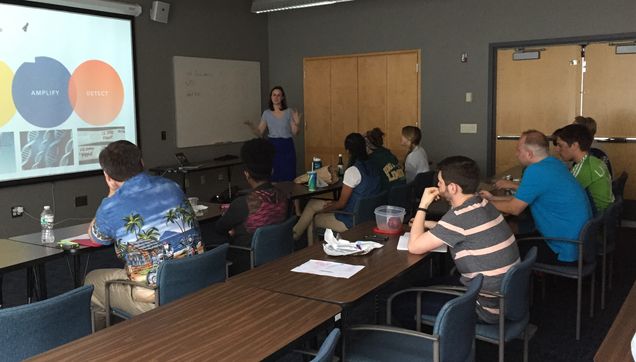 Biomedical, Materials Science and Mechanical Engineering. She provided interesting insight of how engineering disciplines are working with medical professionals to try to create point of care testing with more rapid diagnostics and simpler tests that will allow better treatment plans to those in need or at risk. She described the translational nature of the investigations and projects through the Future Technologies in Cancer Care. She taught the group the differences between pregnancy tests at home that have high protein levels where as other tests that use different bodily fluids or do not express such high protein levels require amplification. Amplification processes are complicated methods that are used and her research groups are trying to implement these complicated methods to develop at home tests with the ultimate goal of the point of care devices is to have them include read-outs similar to the pregnancy test that can be read by user at home. Microfluidics is the basis of achieving this goal along with silica beads to grab the DNA or RNA necessary for the next step of processing in the diagnostic. For those contemplating engineering disciplines, this brown bag seminar provided insight into how engineering disciplines are being sought by the health sciences. Working alongside clinicians and scientists, engineers continue to make an impact on society and outcomes of engineered prototypes are making a difference in diagnostics around the world.
Biomedical, Materials Science and Mechanical Engineering. She provided interesting insight of how engineering disciplines are working with medical professionals to try to create point of care testing with more rapid diagnostics and simpler tests that will allow better treatment plans to those in need or at risk. She described the translational nature of the investigations and projects through the Future Technologies in Cancer Care. She taught the group the differences between pregnancy tests at home that have high protein levels where as other tests that use different bodily fluids or do not express such high protein levels require amplification. Amplification processes are complicated methods that are used and her research groups are trying to implement these complicated methods to develop at home tests with the ultimate goal of the point of care devices is to have them include read-outs similar to the pregnancy test that can be read by user at home. Microfluidics is the basis of achieving this goal along with silica beads to grab the DNA or RNA necessary for the next step of processing in the diagnostic. For those contemplating engineering disciplines, this brown bag seminar provided insight into how engineering disciplines are being sought by the health sciences. Working alongside clinicians and scientists, engineers continue to make an impact on society and outcomes of engineered prototypes are making a difference in diagnostics around the world.
NSF Program Manager Garie Fordyce visits NSF REU INM site, July 20, 2015
 The team welcomed NSF Program Manager Garie Fordyce, who spent some time with us in the afternoon learning about the REU site and the participants. He was very impressed with our website and was happy to see an undergraduate in COM lending their expertise to an engineering site. Garie’s visit reinforced recruitment techniques for next year’s REU program and was pleased to see that in addition to the science and research efforts that this REU site also offered opportunities to reach out to the Boston community and to explore Boston while the students were in town. After a discussion with the PI’s, Garie went to the labs to meet several of our REU participants. Jesus was able to explain to Garie his work in Prof. Bifano’s laboratory and also admitted that before this experience, he did not have training in optical alignment or lasers integrated into optical set ups. Jesus’ hands on training was evident as he confidently spoke of the discrete components and the framework of the deformable mirror that is in his set up. Later, we visited Jake in Prof. Dennis’ laboratory. Jake was able to talk about quantum dots and explained what they were and what the research project this summer was going to lead to for future research in the Dennis lab. The team thanks Garie for visiting with us and providing feedback and advice for recruitment in future years.
The team welcomed NSF Program Manager Garie Fordyce, who spent some time with us in the afternoon learning about the REU site and the participants. He was very impressed with our website and was happy to see an undergraduate in COM lending their expertise to an engineering site. Garie’s visit reinforced recruitment techniques for next year’s REU program and was pleased to see that in addition to the science and research efforts that this REU site also offered opportunities to reach out to the Boston community and to explore Boston while the students were in town. After a discussion with the PI’s, Garie went to the labs to meet several of our REU participants. Jesus was able to explain to Garie his work in Prof. Bifano’s laboratory and also admitted that before this experience, he did not have training in optical alignment or lasers integrated into optical set ups. Jesus’ hands on training was evident as he confidently spoke of the discrete components and the framework of the deformable mirror that is in his set up. Later, we visited Jake in Prof. Dennis’ laboratory. Jake was able to talk about quantum dots and explained what they were and what the research project this summer was going to lead to for future research in the Dennis lab. The team thanks Garie for visiting with us and providing feedback and advice for recruitment in future years.
Brown Bag Seminar – Introduction to Photonics, July 15, 2015 Prof. Roberto Paiella
Professor Roberto Paiella engaged our undergraduates in a discussion on Introduction to Photonics. Prof. Paiella is Lauren Strong’s PI this summer and we were thrilled to have him address our REU and RET participants. We learned about optical engineering and careers and applications of photonics. We covered the basics of what is light and how do we create it and finally what can we do with it?
Prof. Paiella described constructive and destructive interference by describing if you take two waves interfering, the resultant wave could be larger or smaller depending on the waves and their phase difference. A soap bubble example was given to the audience to remind them of the colors they see result from the interference between ambient light and the thin film (soap bubble). The light goes through the film and reflecting back from the surface, is a great example of constructive and destructive interference as a result of film thickness differences. The most important lesson for the group was to remember light is made up of waves and particles.
FEI’s Outreach – July 14, 2015 – Brandon Van Leer’s microscopy seminar
Brandon Van Leer, Business Development & Product Marketing Engineer from FEI in Hillsboro, OR arrived at Boston University Photonics Center on Tuesday, July 14. He spent some time on the instrument with FIB/TEM Facility (FTF) Laboratory Manager, Alexey Nikiforov, preparing for FIB workshops on Wednesday and Thursday morning. Brandon gave an overview of FEI as a company and the exciting applications utilizing a Focused Ion Beam (FIB) system this afternoon, describing beam parameters, how the FIB works and what types of structures can be fabricated in the system. Over the next two days, Brandon will work directly with our undergraduates to help them understand the instrument capabilities and the applications of the tool to nanotechnology. We wanted to provide a thank you to FEI for providing this phenomenal outreach to our undergraduates and teachers.
Brandon gave an overview of FEI as a company and the exciting applications utilizing a Focused Ion Beam (FIB) system this afternoon, describing beam parameters, how the FIB works and what types of structures can be fabricated in the system. Over the next two days, Brandon will work directly with our undergraduates to help them understand the instrument capabilities and the applications of the tool to nanotechnology. We wanted to provide a thank you to FEI for providing this phenomenal outreach to our undergraduates and teachers.
Brown Bag Seminar – July 8, 2015 – Nanoscribe and Nanotechnology
We had a real treat today with Charles Lissandrello, former BU graduate student from Professor Kamil Ekinci’s Lab and a current postdoctoral researcher in Professor Alice White’s Multiscale Laser Lithography Lab – ML^3. Charlie spent some time with the REU and RET participants describing how the Nanoscribe instrument in their laboratory works and how to generate Nanoscribe designs to ensure appropriate structures are chosen for writing. Our undergraduates will have an opportunity to work directly with Charlie to prepare their 3-D nanoscale devices in a few weeks. This fascinating technology generated lots of questions on how the structures are made and how the exposures are done.

Following Charlie’s discussion on the Nanoscribe, Professor Helen Fawcett engaged the student and teacher participants in a flipped presentation where they generated answers to what is a nanometer, what is nanotechnology and more importantly, how did they define what Integrated Nanomanufacturing actually means. Ela provided the interesting quote that your fingernail grows at about 1 nm/second. Professor Fawcett had found that same interesting statement and provided the students and teachers with a link to an interactive lab activity to prove or disprove it.
Welcoming the RETs! – July 6, 2015
Yesterday, the REUs stepped up to the podium and presented themselves and their work to the RETs. Soon, the RETs will be joining them in the lab, learning and researching side by side. Watch some of our REUs, Rachel Walter and Stephanie Emenyonu share a little bit about themselves.
Cleanroom REU Group 2 Metal Deposition and Lift off – June 25, 2015
Our second group of REU students decided to keep one wafer coated in gold and lift of the other – check out their results!
Preparing for the Future….Brown Bag Seminars – June 17 and 24, 2015
 For the last two weeks, the REU’s have packed their own lunches and eaten together during brown bag seminars focused on graduate school and career development. The undergrads were given unique opportunities to meet with Prof. Sol Eisenberg, Senior Associate Dean for Academic Programs, to discuss the process for applying to graduate school and Assistant Director of the Engineering Career Development Office, Subhadra England to discuss career development and searching for jobs in industry. Both speakers provided insight and helped in discussions with the students of where they want to go from here, but most importantly, how to get there?
For the last two weeks, the REU’s have packed their own lunches and eaten together during brown bag seminars focused on graduate school and career development. The undergrads were given unique opportunities to meet with Prof. Sol Eisenberg, Senior Associate Dean for Academic Programs, to discuss the process for applying to graduate school and Assistant Director of the Engineering Career Development Office, Subhadra England to discuss career development and searching for jobs in industry. Both speakers provided insight and helped in discussions with the students of where they want to go from here, but most importantly, how to get there?
 Prof. Sol Eisenberg spent some time with the undergraduates discussing programs that BU has in place but more generally what things to expect when applying to graduate school anywhere. In addition to the expectations, the group also discussed appropriate recommendations, how to approach a person to see if they are comfortable writing a strong recommendation and how to include their research experiences this summer in their applications to graduate school. Prof. Eisenberg, along with Profs. Zhang, Goldberg and Fawcett helped navigate through some of the new Engineering degree offerings as well. It was a great session and the students left with new insight into graduate school and especially BU’s College of Engineering.
Prof. Sol Eisenberg spent some time with the undergraduates discussing programs that BU has in place but more generally what things to expect when applying to graduate school anywhere. In addition to the expectations, the group also discussed appropriate recommendations, how to approach a person to see if they are comfortable writing a strong recommendation and how to include their research experiences this summer in their applications to graduate school. Prof. Eisenberg, along with Profs. Zhang, Goldberg and Fawcett helped navigate through some of the new Engineering degree offerings as well. It was a great session and the students left with new insight into graduate school and especially BU’s College of Engineering.
Subhadra England from BU ENG’s Career Development Office came to discuss some first steps in the job search for engineering  careers. The College of Engineering’s Career Development Office can provide guidance for students looking to pursue jobs in industry. They have connections to employers anywhere from biomedical engineering to electrical, materials science to mechanical and everything in between. England began by explaining the importance of building yourself as a brand with your own marketing material. This includes your resume, LinkedIn profile, on-line presence, a portfolio and business cards. She guided us through the process of looking for jobs, networking, and contacting potential employers, even preparing for the interview. The REU’s discussed strategies of ways to take this usually daunting and overwhelming process, and turn it into success. Ms. England also encouraged each student to visit their home institute’s career development office for further assistance building their portfolios.
careers. The College of Engineering’s Career Development Office can provide guidance for students looking to pursue jobs in industry. They have connections to employers anywhere from biomedical engineering to electrical, materials science to mechanical and everything in between. England began by explaining the importance of building yourself as a brand with your own marketing material. This includes your resume, LinkedIn profile, on-line presence, a portfolio and business cards. She guided us through the process of looking for jobs, networking, and contacting potential employers, even preparing for the interview. The REU’s discussed strategies of ways to take this usually daunting and overwhelming process, and turn it into success. Ms. England also encouraged each student to visit their home institute’s career development office for further assistance building their portfolios.
I scream, you scream, the REU’s scream for Ice Cream – June 24, 2015
The Photonics Center sponsored the annual ice cream truck in the alley this afternoon. The REU’s got their labs to take a few minutes to break from research and test out the latest ice cream innovations!
Cleanroom REU Group 1 – Metal Deposition and Lift Off – June 24, 2015
Our students worked on the CHA and coated their wafers from the week before with gold. Then they completed lift off and ended up with some exciting images of the masks they made themselves!
Group 2 – June 18, 2015
Our second group of NSF REU students spin wafers, UV expose them with their own masks, develop and bake.
This morning in the Clean Room… – June 17, 2015
Group 1 of the REU’s entered the cleanroom at OPF for the first time to spin and expose their own wafers. Here are some pictures to show our progress…
Freedom Trail Excursion – June 14, 2015

Also check out this cool video of Jesus Ramos singing the Puerto Rican national anthem to accompany the glass harmonica outside of the old church! IMG_0276
And We’re Off…. – June 9, 2015
The REU’s joined together bright and early Tuesday morning to share donuts and introductions. Before the eager undergrads could jump right into the lab, some training was required. Laser safety, OPF and basic lab safety training sessions were all completed before lunchtime. The undergrads also got to meet their mentors with whom they will be working with over the next ten weeks. The excitement in the room was tangible as the grad students and postdocs discussed their work with the undergrads.
One student from the University of New Hampshire, Salimah Hussien, shared her experiences and interests in bioengineering with her mentor, Professor David Bishop from the department of Materials Science Engineering. After only her first year of college, Salimah is an active member of NSBE, the National Society of Black Engineers, and the Society of Women Engineers. Originally from Ethiopia, Salimah is a great addition to the engineering community here on BU’s campus. Over the next ten weeks, Salimah and her mentor Professor Bishop will be working on Atomic 3-D printing in the laboratory, and we are excited to see what they discover.
and interests in bioengineering with her mentor, Professor David Bishop from the department of Materials Science Engineering. After only her first year of college, Salimah is an active member of NSBE, the National Society of Black Engineers, and the Society of Women Engineers. Originally from Ethiopia, Salimah is a great addition to the engineering community here on BU’s campus. Over the next ten weeks, Salimah and her mentor Professor Bishop will be working on Atomic 3-D printing in the laboratory, and we are excited to see what they discover.
As part of the introductory day, faculty also presented information on how the REU projects integrated within the laboratory research goals. Professor Thomas Bifano, the Director of the Boston University Photonics Center and Professor of Mechanical Engineering, has been working with graduate students in the Precision  Engineering Research Laboratory to use deformable mirrors to improve optical imaging systems such as microscopes and telescopes. One of the goals for his mentee, Jesus Ramos, is to build a Partitioned Aperture Wavefront (PAW) reflective optical surface-mapping instrument that will be able to measure topography at high speed. Jesus has a lot of work ahead of him, filled with learning opportunities and discovery.
Engineering Research Laboratory to use deformable mirrors to improve optical imaging systems such as microscopes and telescopes. One of the goals for his mentee, Jesus Ramos, is to build a Partitioned Aperture Wavefront (PAW) reflective optical surface-mapping instrument that will be able to measure topography at high speed. Jesus has a lot of work ahead of him, filled with learning opportunities and discovery.
The first day was a success and the undergrads can now head to their labs for lab-specific training and then they will be ready to go. We look forward to seeing what these young minds are capable of during our summer together.
Gearing Up For Summer – May 28, 2015
As the first day of the REU program quickly approaches,  the Undergraduate Research Opportunity Program (UROP) and the National Science Foundation Research Experiences for Undergraduates (REU) and Research Experiences for Teachers (RET) mentors gear up and prepare to take an undergraduate or middle school/high school teacher under their wings for the summer. The mentor/mentee relationship is a perfect arrangement between an intelligent and inquisitive participant and a knowledgeable and experienced engineer or scientist. It not only benefits the participant and the mentor, but the future of research!
the Undergraduate Research Opportunity Program (UROP) and the National Science Foundation Research Experiences for Undergraduates (REU) and Research Experiences for Teachers (RET) mentors gear up and prepare to take an undergraduate or middle school/high school teacher under their wings for the summer. The mentor/mentee relationship is a perfect arrangement between an intelligent and inquisitive participant and a knowledgeable and experienced engineer or scientist. It not only benefits the participant and the mentor, but the future of research!
Bennett Goldberg, Professor of Physics and a mentor of biomedical engineering research for REU/RET participants, led the other mentors in a training workshop in preparation for the start of the summer programs. They discussed methods of interacting with their mentees, how best to  share their knowledge and guide the participants through their research, and ultimately, to success. Great minds sat around tables and shared their past experiences with each other, guided by questions from Goldberg and role playing exercises. Through these exercises, the mentors assumed the roles of both mentor and mentee, providing them with different perspectives on how to best interact with their eager participants. Many great ideas were discussed and connections were made between mentors. By the looks of it, the researchers are in for an exciting summer filled with learning opportunities and interacting with some of the best mentors Boston University has to offer. We eagerly await the arrivals of many great future researchers.
share their knowledge and guide the participants through their research, and ultimately, to success. Great minds sat around tables and shared their past experiences with each other, guided by questions from Goldberg and role playing exercises. Through these exercises, the mentors assumed the roles of both mentor and mentee, providing them with different perspectives on how to best interact with their eager participants. Many great ideas were discussed and connections were made between mentors. By the looks of it, the researchers are in for an exciting summer filled with learning opportunities and interacting with some of the best mentors Boston University has to offer. We eagerly await the arrivals of many great future researchers.

